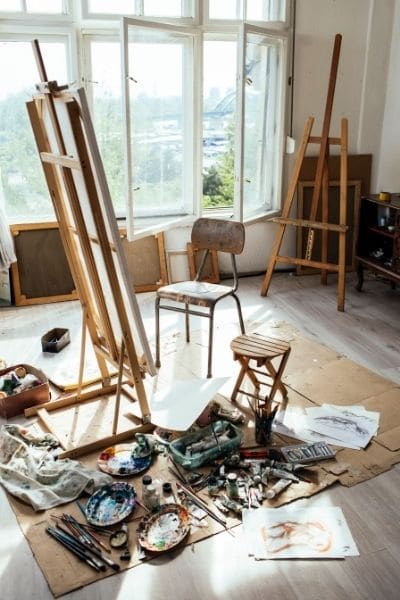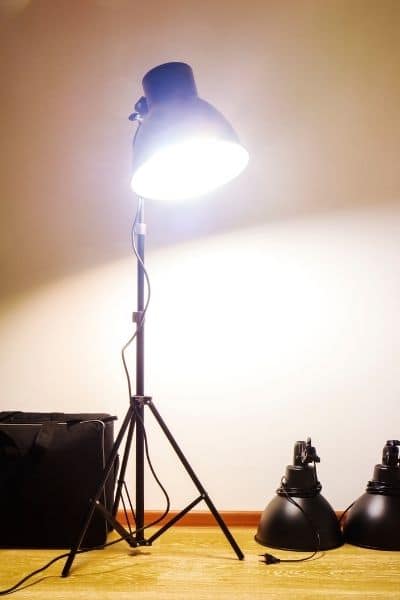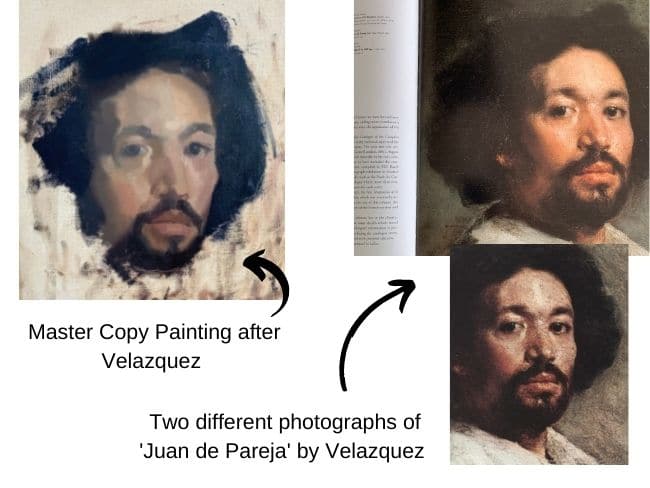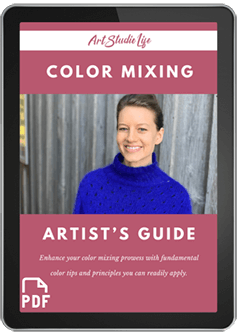When it comes to your artist studio one of the most important things to consider is lighting. Good artist lighting for painting is essential for seeing the colors in your work correctly and ensuring that you’re able to produce your best work.

The most ideal lighting situation for a painting studio is to have natural lighting with a north facing window as it keeps the most consistent light throughout the day. Natural daylight allows you to see colors the most accurately while regular indoor lights will change how colors look significantly.
So, what do you do if your studio is in a windowless basement? Or if you want to paint in the evenings after the sun has already set? Let’s start out by taking a look at the different lighting options for your art studio.
Artist Lighting for Studios

For artists who need to use artificial lighting in their art studios, there are a lot of different options available. Some of the best options include:
- LED lights
- Halogen Lights
- Fluorescent Lights
Each type of light has its own benefits and drawbacks, so it’s important to choose the type of light that will work best for your specific needs.
Lighting and Accurate Color
Before we start getting into specific lights for painting you can use in your artist studio, there are a few things to take into account. The Color Rendering Index (CRI) and color temperature are two important factors to consider, as they can affect how you perceive colors when you are painting.

The CRI is a measure of how accurately a light source can render color. Light sources with a low CRI may look fine to us, but can result in poor color rendering for an artist studio. Lighting with a high CRI, on the other hand, appears more accurate and natural and will help artists’ eyes adjust faster. Lights that have a CRI of 80 or more is recommended for artists’ studios, while 95+ is considered ideal. Notice this illustrated in the graph above
Color Temperature in Lighting
While the CRI will tell you how accurate the lighting source is, it does not indicate whether colors will be warm or cool. For this, you will need to look at the color temperature of the light. To make it easier to understand, here is a list of some common color temperatures and what they look like:

Color temperature refers to the warmth or coolness of light, usually in degrees Kelvin (K). Lighting with a higher color temperature will look more bluish and lighting with a lower color temperature more yellowish. 4600K – 6500K is considered the ‘daylight’ range of light. 5000K is considered to be the best choice for artist lighting as it provides the most ideal color temperature that is similar to daylight in the lighting spectrum.
Light Fixtures for Painting
We live in a day and age where artificial lighting can mimic daylight. This means that we have a variety of different options to choose from when it comes to getting the right type of lighting for our studios. We will explore some of those different options available to us!

LED Lights for Painting
LED lights are a great choice for artist lighting because they provide consistent, bright light without generating a lot of heat. They also last a long time and use very little energy, making them a cost-effective option. However, LED lights are an investment and can be quite expensive to purchase initially. They are well worth it though for the time you will spend in your studio!
If you already have appropriate light fixtures and all you need are LED light bulbs here is a great option:
Touchstar 5000K CRI 90 + (a high CRI is important for art studio lighting)

LED Photo lights for painting
If you would like to be able to light up a large portion of your studio but also be able to create a spotlight these photography lights work great for painting.

Clip on Stand Light
Here is a classic clip on stand light that will give you great illumination while also functioning as a spot light for a still life or portrait.

Fluorescent Lights for Artist Studio Lighting
Fluorescent lights are a popular choice for artists because they are affordable and provide a lot of light. They are a popular choice for general lighting in many spaces. They provide broad, bright light that is perfect for illuminating large areas. Fluorescent lighting can be found in schools, offices, and other commercial spaces. However, they are very useful in art studios as they help give artists the proper light exposure they need.
Overhead fluorescent artist lighting
These particular lights for painting are great if you need to illuminate a larger area in your studio.
Lumichrome full spectrum fluorescent lamps
To replace bulbs for a fluorescent lighting fixture you can get the fluorescent lamps shown below. You will simply need to put them into your existing T12 fluorescent lighting fixture like the one shown above.

Using artificial artist lighting for master copy paintings
I personally mostly use natural daylight from a window when I paint. However, I do from time to time use artificial light if I paint in the evenings to do master copy study paintings. Seeing accurate color while doing a master copy study is not as important as when painting from life because the photo of the painting I copy from is not the same color as the original painting that hangs in the museum. If you look up any painting online you will notice many different color versions of the same painting because each camera captures the colors differently.

Look at the above image as an example. You can see an unfinished study/ copy of ‘Juan de Pareja’ by Velazquez. Then to the right you will see two different photos of the same painting. Notice how the colors are very different in just these two images alone!
Observing and studying the value structure of a painting is much more important than capturing accurate color when doing a master copy study. You will be able to see accurate values no matter if you are using real daylight or artificial light.
Choosing the Best Lighting for Your Art

We are lucky to live in an age where we have the technology available to us to mimic daylight in our own studio! So, it is fully possible to be able to paint from life using the proper artificial light and also mix up accurate and beautiful colors. The lighting you choose really depends on your specific needs as outlined earlier in this article. In general, LED lights and fluorescent lights are the best choice due to their low cost and high CRI.

Proper lights for painting is absolutely essential to have in a studio, no matter what type of art you are interested in. Lighting can make or break a piece, so take the time to choose the right kind for your particular needs! Whatever light you do choose, be sure to take into account the CRI and color temperature to get the most accurate results. And always remember, natural light is still the best light! 🙂
Want to remember this? Save How to Choose the Best Artist Lighting to your favorite Pinterest board!







17 thoughts on “How to Choose the Best Artist Lighting for Your Painting Studio”
Thank you so much for your thorough article on lighting. I’m setting up a studio in a room in my new home and this article was the most comprehensive I’ve found. I will be checking out your other articles and resources in the future.
Thank you for sharing, am glad to hear that!
Hi Elizabeth,
I am seeing up a painting studio with northeast light source. I would like to use track lighting to lift the
space. Can you recommend a track lighting system that takes LED bulbs? Would I want the 5000K lights
to get a natural light? Thanks. Phoenix
Hi Phoenix, Yes you would want to look at getting 5000K lights for your LED track lighting system. Here are some track lights that are 5000K and have a 90+ CRI index – which is also very important!
I’m redesigning a room in our house to be a quilting studio. Currently, it’s so dark. Researching paint and lighting options.
Your post was great at detailing why certain bulbs are needed. This is really useful information as I’m looking at lighting options for this room.
Hi Elizabeth, very useful info. Do you have a recommendation for the number of lumens I should have for my watercolor painting table? I’ve read some wildly variable numbers from 1500 to 20,000. Thanks much.
Hi Terry! Yes, there can be some wide ranges of numbers out there. One of the reasons for this is that the amount of lumens you need depends on how far away you will be from the light source. You will need more if you are further away from it. 20,000 sounds like far too much however. Most lighting situations need around 1,500 – 2,000 lumens. If your light source is fairly far away I would go higher. I hope this helps!
Hi -(I’m so enjoying your videos and the color mixing master guide!!) I bought the neewer light kit you suggested – I dont think there was any information on the CRI index that you indicated was important ( or I just missed it?!)-also wondering what you think of the neewer 660 LED lighting kit adjustable panel kit? I see it has adjustable cool/ warm but guessing that’s irrelevant for daylight needed because wouldn’t need to adjust? not sure how it compares or CRI on that one- is there any reason to prefer one over the other ( I do see that LED panels are not one of your suggestions) . I would so appreciate this extra guidance!! Thank you!
Hi Susan, I am SO glad that you are enjoying my videos and the color mixing master guide! That is wonderful that you bought the neewer light that I recommend – that is the brand that I have. I do have the one that is adjustable with cool/ warm settings – however I never use this for painting – only for taking photographs for this blog 🙂 For painting I only ever use the cool light. If you wanted the flexibility to use the light for other things beyond painting then it would be very useful! Here is one that is adjustable with temperature and also has an excellent CRI index. Please feel free to e-mail me if you have any further questions – am happy to help. ([email protected])
Hi. Thanks for elaborating the lightning of studios. But can you please comment on whether to use warm (yellowish) or crispy white. Both is available in LED. Or mix the two i.e., 50-50%
Good question – the temperature of the light (whether it is yellowish or crispy white) will depend on what temperature of light you purchase. In the article I recommend 5000K lights which will be more of a crisp white light and most similar to daylight 🙂
This is very interesting and could explain why my colours are off thanks Elisabeth
So glad to hear that this was helpful Warren!
Hello Elizabeth! I’m really enjoying your emails! Living in central Alberta, Canada means very little light during the winter, so when we built our house we chose a plan with LOTS of windows. The natural light is wonderful for color accuracy and detail.
Val
Hi Val, Glad to hear that!:) I can imagine that you don’t get much light being that far up north in Alberta, Canada! That was a very smart move to build your house with lots of windows. Am sure it helps a great deal!
Elizabeth, Wow, this came in at the perfect time, thank you. I don’t know if you remember me, I took your class last
February and I loved it. I could not finish cause I moved. It took all this time to finally complete my project. Everything was ordered in March, finally came in and now I am living here …in beautiful stimulating Jupiter Florida, right
off the beach. I also want to thank you for the cloud painting techniques and the beach scene information you sent back in September. All that information in addition to your color mixing guide took my paintings to a different level. I now see how light and color work to create atmospheric and linear perspective. Plus, I can finally see color and mix it, something I struggled with for many years.
I just finished an art studio and researching lighting, I bought a floor lamp off of Amazon just to help till I found the perfect one, and now I know how and what to choose. Thank you so much, Joanne Amodeo
Hi Joanne, So good to hear from you! I definitely remember you from the course last February! 🙂 Wonderful to hear that you are enjoying a great stimulating environment in Jupiter Florida. It can’t get much better being right off of the beach! Also very glad to hear that the cloud painting techniques as well as color mixing information has brought your painting to another level. It is so wonderful to see ones painting change and develop! makes me very glad to hear 🙂 Thanks for sharing!